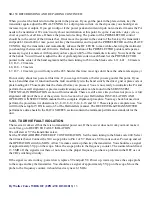
By Walter Cates WD0GOF (UPDATE 10/30/2013)
22
3-2. MICROPHONE SELECTION
This has been a much maligned and argued topic. So I am going to stick to the few stated facts and specs that
we can sift from the manuals. The following does apply to the SR-150/160/400’s/500/2000.
From Hallicrafters documentation:
1.
The
dynamic
mic was the recommended mic. This was found in several brochures and other documents.
2.
The rig’s mic preamp input Z for the 160 and 500 is stated to be 48K. For the 150, 400’s and 2000 is stated to
be 100K
3.
With mic gain at max no more than 4 millivolts (RMS) at the mic input will be required to produce the
minimum specified ssb output in the phone portion of any band.
4.
Hallicrafters testing procedures clearly state that the TX frequency response tests are performed with an
audio oscillator with a
600 ohm
output Z.
From the AUDIO ENGINEERS SOCIETY (
www.aes.org/e-lib
)
1.
Microphone output is measured at a dB level relative to: A, 0db=1volt per microbar or B, 0db=1 volt per
micro Pascal. Both the microbar and the micro Pascal are units of measure of air pressure on a given area of
surface.
2.
There is a 10db offset between the microbar and the micro Pascal scales.
3.
The load on a microphone should be at
least 10 times
the microphones impedance. Loading a microphone at
or near its characteristic impedance will skew the frequency response and allow increased cable magnetic and
RF pickup.
From the spec sheet circa 1963 for both Shure and Turner:
1.
500 to 1200 ohm Dynamic mics were specified to provide a -50 to -52 dB signal into a 100K load using the
microbar standard (Shure 405K Shure used the term “controlled magnetic” for their Dynamic mic).
2.
Most of the Dynamic mics were specified to be operated into a 100k or higher load.
Assumptions:
The Hallicrafters specs state: The microphone preamp in each rig is hi-Z, either 48K or 100K. They preferred a
dynamic mic. Documentation also uses either 4 millivolts or 5 millivolts (RMS) as the standard mic signal.
Now due to the 10 dB offset from the microbar and the micro Pascal standards I would
assume
that
Hallicrafters was using the micro Pascal standard which was the predominant standard in the 50’s and would
match the 4 to 5 millivolts requirement.
Conclusion:
If you want your SR series gear to sound right: and you abide by the specs and assumptions above: then you
want to find a Dynamic Mic in the order of 500 to 600 ohms that will deliver 4 to 5 millivolts (RMS) into a 48K
or 100K load. If you are unable to find the specs on the mic don’t fret, read the “good stuff” below.
NOW THE GOOD STUFF:
We really don’t need to know anything about the mic. Say you have an unknown mic in the goody box. We
know the input Z for the SR is either 48K or 100K. Then place a resistor equal to the input Z of your rig (either
48K or 100K) across the voice line of the mic and the mic gnd and measure voltage across the resistor when you
speak into the mic. As you speak into the mic and repeat the words
three, four, three, four
you will cover most
of the voice spectrum and the normal max and min volume for
your
voice. If the output voltage does not meet
the 4 or 5 millivolts for the rig it
aint gona work
. Since the MIC GAIN control is two stages after the mic input
you must be careful of over driving the amp. If the mic output level is more than 3 or 4 times the requirement
you will probably over drive and distort the signal in the preamp and sound like you have a mouth full of
marbles.
BTW THE VOLTAGES ARE RMS it would be about 10mv pp if measured with a scope.
Summary of Contents for SR-150
Page 18: ...By Walter Cates WD0GOF UPDATE 10 30 2013 18...
Page 19: ...By Walter Cates WD0GOF UPDATE 10 30 2013 19 BEFORE CLEANING CLEAN CHASSIS...
Page 20: ...By Walter Cates WD0GOF UPDATE 10 30 2013 20 3 1 2 TUBE SOCKET CLEANING KIT...
Page 21: ...By Walter Cates WD0GOF UPDATE 10 30 2013 21 3 1 3 AIR VARIABLE CLEANING...
Page 30: ...By Walter Cates WD0GOF UPDATE 10 30 2013 30 3 5 5 K3 WIRING AND PIN OUT...
Page 38: ...By Walter Cates WD0GOF UPDATE 10 30 2013 38 4 DATA SHEETS...
















































